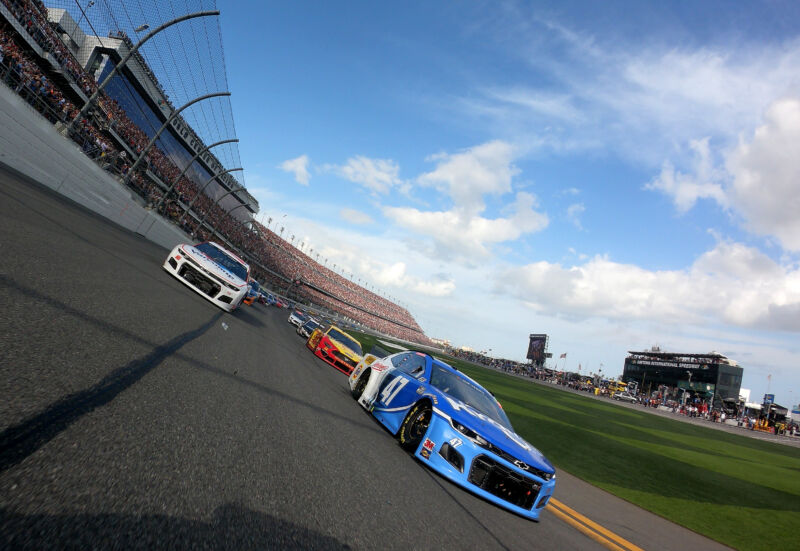
This is a heck of a weekend for racing. At Indianapolis, drivers are qualifying for next Sunday's 500. The WEC saw action at a very wet Spa this morning. Formula 1 is running at Catalunya in Spain, its favorite test track. And NASCAR's Cup series is trying something new.
It was supposed to spend this weekend at Watkins Glen, in upstate New York. But 2020 did its thing, and so the picturesque circuit in the Finger Lakes, once the US home to Formula 1, is out of bounds. So NASCAR will race at Daytona for the second time this year. And for this visit, stock cars are going to use a layout more familiar to fans of the annual Rolex 24 endurance race for sports cars instead of the 2.5-mile (4km) tri-oval.
Well, almost. The 750hp (560kW) stock cars used in NASCAR's cup series are a lot more powerful and a lot lower drag than the 180mph (290km/h) prototypes and the GT cars that race in the Rolex 24. Which would mean approaching turn 1 up to 30mph (48k/h) quicker than those sports cars. And at 3,450lbs (1,564kg), they have considerably more mass that has to be controlled.
"As they started their entry into turn 1, they would be going 210mph [338km/h] and having to slow down to 50 to make the corner, and quickly, we got to the realization that that just probably wasn't going to happen for 65 laps here," explained John Probst, senior vice president of racing innovation at NASCAR.Consequently, the drivers will find an extra pair of corners in the shape of a chicane shortly before the start-finish line, extending the layout slightly to 3.61 miles (5.81km). Creating a speed-shedding chicane isn't as simple as just sticking out some cones on what's usually the speedway's skid pad. Probst's team turned to simulators to make sure the profile of what are now turns 13 and 14 would work properly.
"We tried to tune it so that the cars would enter at roughly 180mph [290km/h]," Probst told me. "And then we wanted to keep the car somewhere near 70mph [113km/h] in the middle of it. So, we configured the geometry of the chicane to get the midcorner speed to about 70."
However, this new chicane now means a lap of the Daytona road course now involves three big braking events—turn 1, the bus-stop chicane (turns 9 and 10), and now this new final chicane. And so, expect brake management to be the order of the day in Sunday's 235-mile (378km) race. For road courses, Cup series stock cars use 12.7-inch cast-iron rotors with six-piston calipers at the front. You might expect the big challenge would be preventing the brakes from getting too hot, but in fact, teams may well have the opposite problem.
"One of the unique characteristics here is that we're going to hit really high speed," Probst explained. "That means a lot of airflow to the brakes. So the brute force approach of 'more air is better to cool brakes' would probably work if it was all twists and turns and braking." But in between the road course's 14 turns are three long stretches of high-speed running.
Don’t let the rotors get too cool
"We're going to have three very significant braking events that are going to get a lot of temperature in the brakes, obviously," Probst explained. "But then you come off turn 6—which is the turn back on to oval turn 1—and you go all the way around to the bus stop flat-out. Looking at the speeds here, we'd expect them in the 190s right now with the high downforce package, and that means they're going to cool a ton by the time they're heading down the bus stop. They're going to get not cold in the sense of frigid cold but cold in the sense of brake rotors compared to where they were on corner entry, and they're going to do that a couple times a lap which leads to cracking with the rotors."
That probably won't mean brake rotors shattering. "When you have failures, it's uncommon for the cracks to be to the level where actually something comes apart," Probst told me, but repeated hot-cold cycles could well lead to handling problems for the drivers. "But what is bad is when they're glowing hot red and then really cool and then glowing red-hot then really cool—eventually they get to the point where you have geometry changes in the rotor itself, typically in the areas where the bobbins would attach and things like that," he said. And unlike an endurance car in a 24-hour race, there's no provision made for quick brake jobs on a stock car.
The upside for fans in all of this is that longer brake zones make more opportunities for overtaking. How much longer? For braking into the bus stop, Probst told me NASCAR, erring on the conservative side, has put out four extra distance markers this weekend.
"had" - Google News
August 15, 2020 at 11:35PM
https://ift.tt/3gV9KI9
NASCAR had to tweak the Daytona road course for stock cars—here’s why - Ars Technica
"had" - Google News
https://ift.tt/2KUBsq7
https://ift.tt/3c5pd6c
Bagikan Berita Ini














0 Response to "NASCAR had to tweak the Daytona road course for stock cars—here’s why - Ars Technica"
Post a Comment